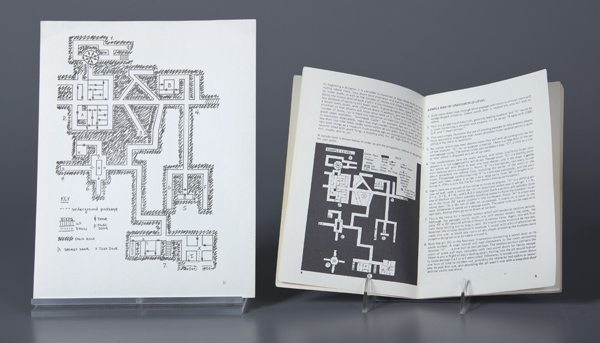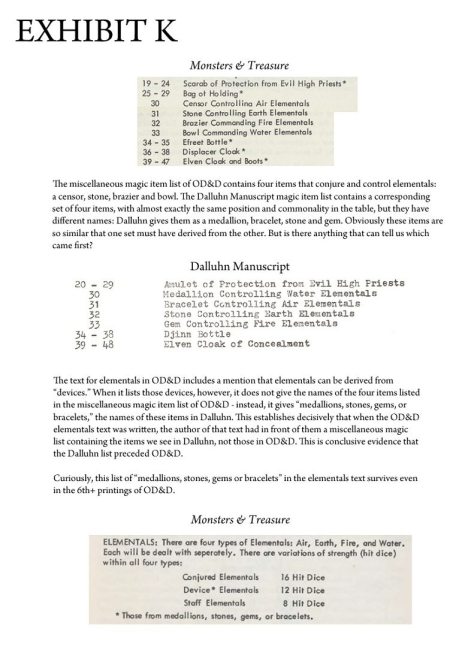
Followers of gaming history care passionately about how the beloved and groundbreaking game, Dungeons & Dragons, was created. A newly-analyzed manuscript sheds light on some of the mystery surrounding D&D’s origins. But the document also raises further questions.
According to a statement released by The Strong National Museum of Play, “A rare manuscript believed by some experts to be the earliest existing version of Dungeons & Dragons” is now on display at their Rochester, NY, museum, as part of an exhibit called Game Time! that explores three centuries of “games, puzzles, and public amusements.”
At issue: two hand-typed volumes known as the “Dalluhn Manuscript,” now owned by D&D scholar Jon Peterson, which details aspects of D&D gameplay such as combat, spells, magic items, monsters and alignment. The manuscript may be pivotal to solving the puzzle of how D&D’s early rules were developed.
The Dalluhn Manuscript, Peterson said, “I believe is the earliest surviving version of D&D.” Peterson is the author of the book Playing at the World, which charts the vast and complex history of tabletop role-playing and simulation games.
So was the Dalluhn Manuscript used for play-testing D&D? Or was it actually an early prototype for the game? Peterson thinks he knows the answer.
“I’ve spent the past couple of months analyzing this document and I think I have a very solid foundation of evidence that the rules in this document predate D&D, and that D&D is derived from the system it contains.”

Peterson said the 50-page manuscript “was found in the garage of one of the early Twin Cities players along with some other very early gaming material.” (That garage belonged to, as it turned out, M.A.R. Barker, author of Empire of the Petal Throne game.) It’s called the “Dalluhn Manuscript” because of its previous owner, Keith Dalluhn.
In a recent email exchange, I pressed Peterson further to be more definitive and specific. Here are his thoughts:
“I think my research demonstrates pretty conclusively that the editors of D&D (Gygax and Arneson) had this system in front of them when they were producing D&D, and that the system preserves early ideas closer to Chainmail and Blackmoor that were eventually discarded or modified for inclusion to D&D.” This version of the rules, Peterson wrote, probably circulated in the spring of 1973 for editing and most likely playtesting.
In his statement in The Strong’s press release, Peterson was also quoted as saying, “The Dalluhn Manuscript preserves a transitional set of rules developed during the creation of the game Dungeons & Dragons. It captures the system at around the midpoint of development, with the core concepts of dungeon exploration and fantastic combat in place, but it lacks some features of the mature game and exhibits a few intriguing variations.”
So who actually produced this draft? Gygax? Arneson? Someone else? Who held the pen for the various drafts of D&D’s rules? That question is harder to know.
“It’s a bit tougher for me to say conclusively who typed and Xeroxed it (in fact the document shows signs of multiple persons working on it), but actually that’s a tough question to answer about many things in the published D&D game as well,” Peterson said. “My analysis doesn’t answer every question about this, but I think it does establish that essential causal chain showing that this document is a stepping stone between the early Chainmail/Blackmoor work in OD&D.”
Some people have claimed that Gygax borrowed (or, less charitably, “stole”) key ideas Arneson, or that Gygax adopted idea from other people and never credited them. Peterson was clear that this manuscript does not prove that either man borrowed or stole ideas from anyone.

Whoever wrote or typed it, clearly the manuscript combines elements contributed by both Dave Arneson and Gary Gygax, “including many discarded concepts,” Peterson said, “that can be proven to have been in use at the time Dungeons & Dragons was written.”
In a comment in response to a comment about the manuscript, posted on his website, Peterson proposed a plausible explanation as to why at this time, we still can’t know the manuscript’s exact chain of influence. “I have gotten the impression that most of this history has not only been forgotten, but for the most part people have forgotten that they ever even forgot anything about it.”
Maybe it was a purer version of the game that Arneson had shown to Gygax. “It might be ‘MY DRAFT.’ The one I sent Gary way back when. OR his first draft back. Either way it is VERY COOL,” Peterson reported Arneson as saying when Keith Dalluhn had contacted Arneson after finding the document. Or maybe it came after D&D, as Gygax himself had claimed when Dalluhn contacted him. Gygax, who saw some excerpts of the document, reportedly claimed that it “seems to be a rip-off of the D&D game that I’ve never seen before.”
But then again, memory is not terribly reliable, especially when “No one at the time knew that the gaming events of 1973 would be worthy of remembrance,” Peterson continued on his website. “The moral of my story is that even if I put a document *you wrote* with *your name on it* in front of you, that doesn’t mean you’ll remember it. You don’t get to choose what you remember. You may still deny you wrote it because you don’t remember it. But as historians, what should we believe?”
As a finaI note, Peterson said he was optimistic that, eventually, we will learn more about how the Dalluhn Manuscript came to be. “We just don’t have the evidence to solve that question today. New evidence comes to light all the time, however. I just felt that there was sufficient evidence today to make the most important claim: that there is a surviving pre-publication draft of Dungeons & Dragons. We have a lot to learn from it.”
[NOTE: This is a corrected version of the original post, which had made some of the issues of authorship unnecessarily mysterious. Thanks to input from Jon Peterson, these points have been clarified.]


I just finished “Playing at the World” — long book and very dense in material. It’s a MUST READ for any D&D and/or wargaming and miniature gaming fan.
I sincerely hope that Mr. Peterson considers having this document scanned and republished with his notes and commentary included. This would be a nice item to be able to purchase for those of us into the history of gaming, specifically D&D.
Just to be clear, I don’t think there’s any evidence that Gygax or Arneson stole the core ideas behind D&D from some third party. They did however often engage third parties to type up drafts of their other games, and the evidence suggests they did that in this case as well. A number of people in the gaming circles of the Twin Cities and Lake Geneva contributed ideas and feedback on early versions of D&D, so it did take a village to make the game. Some of them provided editorial help as well, but collectively they do get a credit in the first published edition of the game. This early draft of the game shows us many things about the order that ideas were introduced, what some discarded ideas looked like, and so on, but don’t mistake uncertainty about the typist(s) for uncertainty about the inventor(s).
To James: ideally that would be nice, but do recognize that the intellectual property situation of this document is quite complex. Since large swaths of the text are identical to original D&D, and other parts to Gygax’s earlier Chainmail, at the very least the rights-holder of those games would need to support the publication. It would only get harder from there.
Thanks for these comments, Jon. ***Readers: The errors and unintentional fuzzy areas were my mistake, not Jon’s. I made some corrections to this post to address the issues that Jon raised here.
This is a scam joke, right?
Not as far as is known.